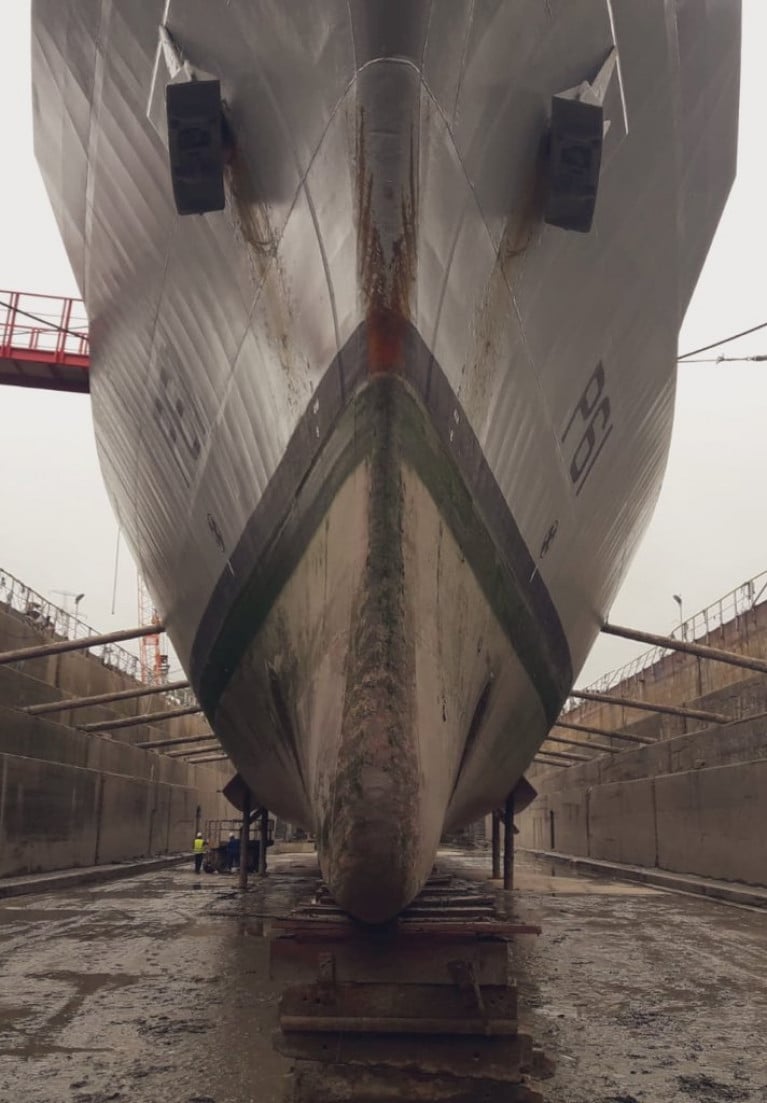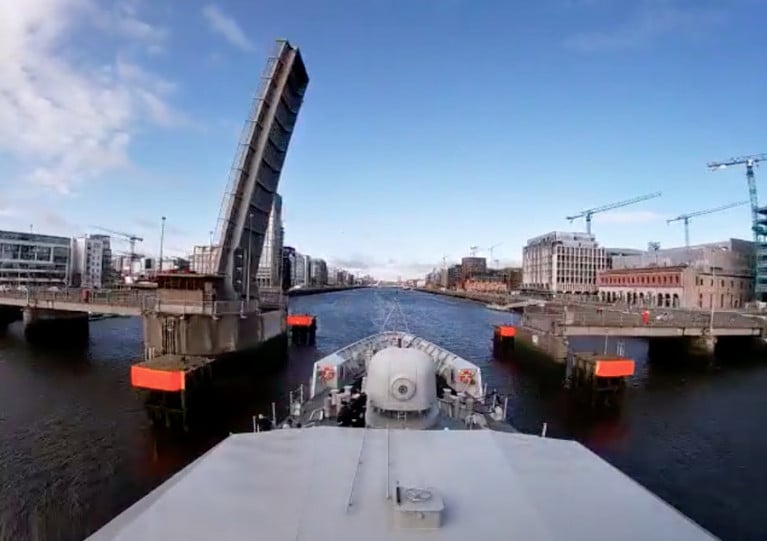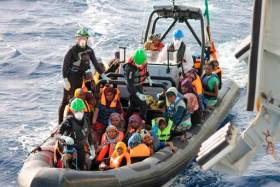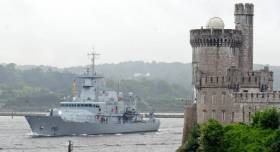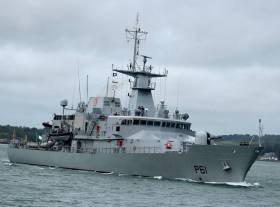Displaying items by tag: LE Samuel Beckett
Cork Dockyard's latest client is the Irish Naval Service's OPV90 /P60 series LÉ Samuel Beckett (P61) which berthed in the graving dock previously occupied by another Irish flagged ship, the general cargo containership Huelin Dispatch, writes Jehan Ashmore.
The facility (were ship's were built) in Cork Harbour, is these days part of the Doyle Shipping Group (DSG) and where leadship of the series also known as the 'Beckett/ Playwright' class is undergoing work. According to the INS this planned maintenance is for below the waterline.
It is an extremely busy time for the entire ship’s crew (44 incl. 6 Officers), as the process of dry-docking the Offshore Patrol Vessel of 90m in length, offers a rare opportunity to conduct work on the hull where otherwise underwater fittings and fixtures are usually inaccessible.
LÉ Samuel Beckett was one of several in the naval fleet that was often in the news headlines of recent years haven taken part in humanitarain missions in the Mediterranean Sea. This involved rescuing thousands of migrants/ refugees under dire circumstances when in unseaworthy craft deployed by people-smugglers off north Africa.
At the same time these deployments also proved to be challenging for the crew.
Such experiences have also helped those personnel in the Naval Service to assist in the recent Covid-19 testing centres that have since been stood down in Dublin Port and Galway Harbour.
In fact the leadship LÉ Samuel Beckett also became the first of the fleet to fight against Covid-19 as part of Óglaigh na hÉireann’s efforts to generate additional capacity for the HSE. This first took place from mid-March when berthed in the Irish capital.
LÉ Samuel Beckett Arrives In Dublin To Shore Up HSE Capacity In Fight Against Covid-19
Naval Service vessel the LÉ Samuel Beckett arrived in Dublin this morning (Sunday 15 March) as part of Óglaigh na hÉireann’s efforts to generate more capacity to help the HSE during the current Covid-19 response.
The Irish Defence Forces said: “P61’s facilities, resources and crew will be ready when requested by primary response agencies to fight Covid-19.”
The latest guidelines for the public are available on the HSE website HERE.
The Naval Service denies any personnel on the LÉ Samuel Beckett were put in danger by the poor state of equipment used to raise and lower RIBs into the water, as The Irish Times reports.
The statement followed an inspection of the vessel — commissioned in 2014 — by the manufacturer of the davits it uses to winch smaller craft, which was conducted shortly after its return from its deployment in the Mediterranean last summer.
The inspection report, released to MEP Clare Daly, found that the davits were “in a far worst state of repair than initially expected” with signs of heavy corrosion, and “showed little or no sign of maintenance”. The Naval Service denied this was the case and said all issues have since been corrected.
The offshore patrol vessel’s davits have been used extensively in the rescue of migrants in the Mediterranean, where it has been deployed a number of times since 2015.
The Irish Times has much more on the story HERE.
Naval Service patrol ship LÉ Samuel Beckett (which this week detained a Portuguese fishing vessel) will be open for public tours when it is docked in the Port of Galway tomorrow, Sunday 25 August.
According to GalwayDaily, Naval Service crew will be taking members of the public on guided tours tomorrow from 10:00-12:00 in addition 14:00-17:00.
The LÉ Samuel Beckett is one of four new patrol vessels build for the Irish Naval Service in the past five years.
The Samuel Beckett the first to roll off the line in 2014, followed by the LÉ James Joyce in 2015, and the LÉ William Butler Yeats in 2016 and LÉ George Bernard Shaw last year.
For more including a photo of the detained Portuguese registered vessel for alleged breach of fishing regulations click here.
Leadship LÉ Samuel Beckett Open to Public in Galway Today Following Fishery Detention
#navy - The Irish Naval Service offshore patrol vessel, LÉ Samuel Beckett, will be offering guided tours to the public in the Port of Galway today, Saturday, 12th January.
The Samuel Beckett writes Galway Daily is currently docked in Galway after it detained a fishing boat for breach of regulations off the west coast yesterday.
The first fishing vessel detained by the naval service this year, it was handed over to Galway gardaí this morning.
While it’s around, the LÉ Samuel Beckett will be open for public tours while alongside this afternoon between 14:00-16:00.
To read more on the leadship of the P60 OPV90 class and sisters, click here
Large Carcass Spotted In Celtic Sea Area Popular With Fin Whales
#MarineWildlife - Naval Service personnel on patrol with the LÉ Samuel Beckett encountered the carcass of a large whale some 50 nautical miles south-east of Ballycotton Lighthouse in the days after Christmas.
The “mystery whale” is neither a sighting (which only counts or living cetaceans) nor a stranding. But as the Irish Whale and Dolphin Group (IWDG) says, the encounter “serves to remind us that the animals that wash up on our shoreline may represent only a small percentage of the total number of cetaceans that expire at sea of presumably natural causes.”
IWDG sightings officer Pádraig Whooley said the location of these whale remains was “interesting as this area of the Celtic Sea has produced the most consistent large-whale sightings in recent months, with fairly regular sightings of fin whales from land-based sites between Ram Head, Ardmore extending east towards the Hook Head lighthouse.”
#NavalService - Naval Service crew from offshore patrol vessel (OPV) LÉ Samuel Beckett arrived home to a heroes welcome today after three months in the Mediterranean on humanitarian rescue operations.
The vessel writes Independent.ie is under the command of Lt Cmdr Eoin Smyth, was cheered to the echo as it rounded Roche's Point in Cork harbour and berthed at Haulbowline Naval base.
Lining the quayside were the families of the 54 crew members - including dozens of children who had missed their enlisted parents since the deployment last May.
LÉ Samuel Beckett was the second Irish patrol ship to deploy to the Mediterranean this year as part of Ireland's commitment to Operation Sofia, the European mission to help migrants attempting to cross from north Africa to the EU.
The OPV has been replaced on station as Afloat previously reported in the Mediterranean by LÉ James Joyce.
For further reading on the return of LÉ Samuel Beckett, click here.
#Navy - Crew members of L.É. Samuel Beckett in Malta last weekend were presented with their Operation Sophia medals from the Irish Naval Service, writes Jehan Ashmore.
Flag Officer Commanding Naval Service (FOCNS) Commodore Michael Malone visited Valletta Harbour last weekend to present the medals to the crew who since April have been deployed in the Mediterranean.
Since the fallout from Libya's boat people trafficking in 2015, the EU launched as a military operation the European Union Naval Force Mediterranean (EUNAVFOR Med) also known as Operation Sophia. The name of the operation was inspired from Sophia, a baby born on board a German Navy frigate whose mother, a Somali refugee was rescued initially by the UK'S Royal Navy.
The 2014 commissioned OPV90 leadship L.É. Samuel Beckett is the second Irish Naval Service patrol ship to take part in Operation Sophia which began last October. On that occasion, OPV80 'Roisin' class LÉ Niamh made history as this was the first time that Ireland joined the EU naval operation tasked against smugglers and traffickers.
Unlike previous other humanitarian missions focusing on Search And Rescue (SAR) of refugees, Operation Sophia among its remit addresses some of the root causes of human-trafficking and migration crisis.
The deployment of LÉ Niamh for Operation Sophia ended late last year. Taking over duties in April this year saw L.É. Samuel Beckett join the EU naval fleet task force comprising of 10 participating member-states.
Following the FOCNS overseas visit to Malta, Commodore Michael Malone conducted another ceremony held in the Naval Base on Haulbowline Island, lower Cork Harbour. This involved an annual inspection of L.É. James Joyce. The second OPV90 class commissioned into service in September 2015 was followed by L.É. William Butler Yeats in October 2016.
OPV LÉ Samuel Beckett Departs On Mission to Counter Human-Trafficking in Mediterranean
#Navy - Leadship of the Irish Naval Service OPV90 class, LÉ Samuel Beckett is departing today for the Mediterranean to take part in 'Operation Sophia'.
As The Irish Examiner reports, Ireland first joined the EU naval operation against smugglers and traffickers last October when another Offshore Patrol Vessel, the OPV80 class LÉ Niamh was deployed for a three-month mission.
Minister with Responsibility for Defence Paul Kehoe says the crew will be helping to address some of the root causes of migration and human trafficking.
For more click this link.
#Navy - A visitor to Waterford City today (Saturday, 24 March) is the leadship of the OPV90 class LÉ Samuel Beckett which is open to the public this afternoon between 2pm and 4pm..
The 'Samuel Beckett' class offshore patrol vessel is the first of a trio of sisters in the Irish Naval Service. The OPV is berthed at Frank Cassin Wharf (north side) of the River Suir.
In addition to the naval crew the Waterford Unit Naval Service Reserve (WUNSR) will be on board in providing information to potential NSR recruits. This is advance of NSR Recruitment Campaign beginning in April and running until June.
The OPV has carried out humanitarian missions in the Mediterranean in recent years under 'Operation Sophia' This involved search and rescue (SAR) operations which led to saving more than 1,000 migrants.
LÉ Samuel Beckett was built by Babcock Marine & Technology, Appledore, north Devon and was commissioned in 2014. The leadship forms part of modernisation programme to upgrade the fleet and so far has led to replacing a trio of ageing 'Emer' class OPV's.
A fourth sister, LÉ George Bernard Shaw earlier this month was floated-out of the building hall at Appledore downriver of Bideford. At that stage of the construction process, the hull and superstructure of the €67m newbuild were completed, though the mainmast and 76mm gun had yet to be added.


























